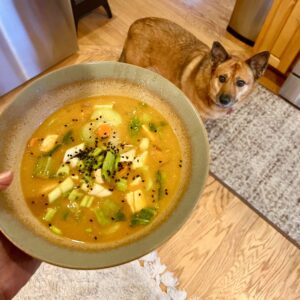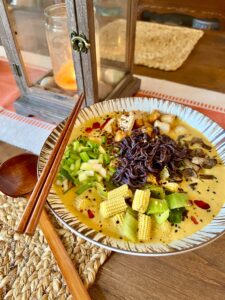
Simple, light miso soup (and a rescue dog!)
There is a Japanese proverb that states “味噌汁は不老長寿の薬” (miso shiru wa furou chouju no kusuri), which means “miso soup is medicine for eternal youth and longevity.” That’s pretty intriguing–who doesn’t want that? 🙂 This warm and nourishing soup has been treasured for over 1800 years in Japanese cuisine and healing traditions (traditional Okinawans, who are famous for their longevity and live in one of the world’s most heavily studied “Blue Zones,” often eat miso soup for breakfast). Over the centuries it has become a staple health food in China, Korea and other Asian countries, and is now easily found in the West.
So what is miso exactly? Miso is a thick, salty fermented soybean paste that looks something like peanut butter and comes in refrigerated tubs. It is made from crushed soybeans, salt, a fermenting agent and the addition of barley, rice or wheat. Depending upon which grain is added, the miso will vary significantly in flavor, texture, aroma and color.
Miso is best known for containing numerous beneficial microorganisms and is often added as a final ingredient in a dish to maximize its probiotic benefits. The list of benefits to health, longevity and beauty is long, and includes:

Heartier miso soup with ramen (I chose black forbidden rice ramen noodles!)
- Miso is incredibly nutritious and linked to a variety of health benefits, including better digestion and a stronger immune system.
- It is 13-20% protein and contains an amino acid pattern that is similar to animal protein.
- Miso is a good source of vitamins and essential nutrients such as vitamin K, vitamin A, thiamin (B1), riboflavin (B2), nacin (B3), pantothenic acid (B5), B6, B12, folate, and choline.
- As a live food, miso contains lactobacillus (the same probiotics that are in yogurt) which aids in better digestion and assimilation of nutrients. Multiple other beneficial bacteria or probiotics are present in miso including bacillus subtilis, bacillus amyloliquefaciens, staphylococcus gallinarum, staphylococcus kloosii and lactococcus. These microorganisms inhibit the human gastrointestinal tract and are associated with improved digestive health.
- Miso contains ceramide that keep the skin hydrated and it is said that a miso soup a day keeps the skin hydrated, plump, and supple!
- Miso may improve the elasticity of the skin. It contains 18 types of amino acids including lysine and proline, which are important for collagen production.
- Rich in antioxidants, miso may slow down the signs of aging. Antioxidants neutralize damaging free radicals in the body, so they are very important in fighting the signs of aging, as well as boosting overall health.
- Miso adds flavor allowing for less fat and oils needed as seasonings in cooking and may be used in place of salt and soy sauce as seasoning.
- Miso helps create an alkaline condition in the body to promote resistance against disease and inflammation.
- Miso has been used to treat certain types of heart disease and cancer.
- Miso neutralizes some effects of smoking and air pollution.
When used moderately by most people, miso provides excellent nutritional benefits. As a higher sodium food however, excessive use may bring on similar problems to extremely high salt use.
Also, some individuals with candida and similar fungal conditions should use miso sparingly as it is a fermented product and can promote the growth of yeasts. If it isn’t organic, miso has a risk of containing GMOs. Unfortunately, 90% of the soy produced in the United States today is genetically modified, putting miso at risk by association. To avoid GMO miso, look for one that is certified organic or states that it has been made without GMO soybeans. Miso made in other countries, such as Japan or Korea, may be less likely to be genetically modified.
Ready to try a little miso in your life? Here are my top three miso recipes… two soups (one light and one heartier) and one dressing to use over any salad or vegetable dish.
ALMOND MISO SOUP
Recipe serves one, may want to double or triple or even quadruple!
1 tsp sesame oil
1 carrot sliced in coins
2 TBS chopped red onion
4 oz. extra firm tofu, cubed
1½ cups vegetable broth
1 TBS yellow miso
1 TBS creamy almond butter
1 scallion, sliced for garnish
¼ tsp sesame seeds (preferably black)
- In a small saucepan over medium heat, heat oil. Add carrots and onions and cook, stirring until tender, about 3 minutes. Add tofu and cook for 5 more minutes.
- Add broth and increase heat to high. Bring to boil, remove from heat and pour ¼ cup of hot broth into small bowl. Add miso and almond butter and whisk until it forms a paste. Stir miso mixture into saucepan. Ladle into a bowl and garnish with scallions and sesame seeds.
SUNFLOWER MISO RAMEN WITH BAKED TOFU
Recipe serves two, may want to triple or even quadruple!
Baked Tofu
14 oz extra firm tofu
1 tsp cornstarch
2 TBS soy sauce or tamari
Sauteed Mushrooms
6 oz Japanese ramen noodles
4 tsp toasted sesame oil, divided
1½ cups sliced mushrooms
1 TBS soy sauce or tamari
Sunflower Broth
1 large shallot
3 cloves garlic
3 TBS roasted sunflower seeds
4 cups mushroom or vegetable broth
3 TBS white or yellow miso
2 TBS nutritional yeast
2 TBS soy sauce or tamari
2 tsp chili oil
1 TBS minced ginger
Pinch red pepper flakes
1 cup corn, fresh or frozen
Garnish
3 scallions
Chili oil
- Preheat oven to 400 degrees F. Line baking sheet with parchment paper. Wrap tofu in clean kitchen towel and press some of the liquid out, then dice into 1-inch cubes.
- Toss tofu with cornstarch, then add soy sauce and coat evenly. Bake on lined baking sheet for 20-minutes, flipping half-way through. Or just air fry tofu cubes with a little soy sauce in air fryer! While the tofu bakes, boil the ramen according to package instructions, then drain.
- Heat 1 tsp of sesame oil in pan over medium heat and add sliced mushrooms. Drizzle with 1TBSof soy sauce. Cook until browned, 3-4 minutes, stirring occasionally. In the meantime roughly chop shallot and garlic.
- Transfer cooked mushrooms to bowl. Put pan back over medium-high heat with 1 tsp of sesame oil.
- Cook shallot and garlic for 3-4 minutes, stirring often, and then transfer to a high-speed blender. Add sunflower seeds, broth, miso, nutritional yeast, soy sauce, the remaining 2 tsp of the sesame oil, chili oil, ginger and pepper flakes to the blender and blend on high until smooth and creamy, about 3 minutes. Chop the scallions as the broth is blending.
- Heat the broth and corn in a saucepan until hot. . Divide broth between serving bowls. Top each bowl with noodles, baked tofu, mushrooms and scallions. Finish with a drizzle of sesame oil.
MISO TAHINI DRESSING
Makes 1-2 servings
1 clove garlic, peeled and minced
2 TBS tahini
1 TBS lemon juice
1 TBS white miso
2 TBS water
- Mix the garlic, tahini, lemon juice and white miso together in a small bowl.
- Spoon in water and stir well.

 Our office is conveniently located in the beautiful 80 Big Springs office building in Nederland, CO. Plenty of close parking is readily available.
Our office is conveniently located in the beautiful 80 Big Springs office building in Nederland, CO. Plenty of close parking is readily available.